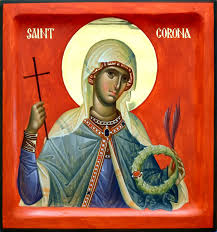
I wrote earlier this year about the significance of May 14 (read Zeus Almighty here and Give Slavery a Chance here). The date is significant for several reasons. May 14 is the day:
- The Vatican initially chose to “launch a global educational pact” (2020)
- Of the Jupiter retrograde (2020)
- The 72-year anniversary of Israel’s statehood will be celebrated (1948)
- The Catholic Church celebrates the feast day of St. Corona
St. Corona, like most things, is shrouded in contradiction, myth, and several fact vs. fiction fallacies. The Catholic Church celebrates this feast day on May 14, while the Eastern Orthodox Church celebrates it on November 11—11.11—no occult implications there, whatsoever, right? (Insert gratuitous eye roll here).
How interesting that the Vatican had a global pact event (read: ritual?) scheduled on the same day that planet Jupiter retrogrades, a Zionist-backed government celebrates an anniversary of biblical proportions, and is also a day set aside by the Catholic Church to venerate a, likely fictional, saint by the name of Corona…all during a Coronavirus shelter in place quarantine. And while the Vatican event has been postponed until October, that is no reason to take our wide awake eyes off of May 14.
Who exactly is St. Corona?
Well, that all depends upon your source.
According to Catholic Online, in their article, “Popular Saints—Saints and Angels,” “Corona is associated with superstitions involving money, such as gambling and treasure hunting, a result of a later treasure hunter who credited his success to invoking her.”
Johannes Dillinger, author of the 2011 book, Magical Treasure Hunting in Europe and North America, adds further that St. Corona “is called upon by a treasure hunter to bring treasure, and then sent away through a similarly elaborate ritual.”
St. Corona—called upon by “treasure hunters” via an “elaborate ritual.” Those dots are not too difficult to connect to sketch out a simple line drawing of this COVID-1984 Plannedemic that we see playing out before our very eyes, now are they?
The Catholic Sun (yes, that’s s-u-n, not S-o-n), the official news media serving the people of the Roman Catholic Diocese of Syracuse, in their March 19, 2020 online article entitled, “St. Corona: Pray For Us!” contributing writer, Renée K. Gadoua writes, “Some Catholics seeking spiritual solace during the coronavirus pandemic are turning to the 2nd century St. Corona (d. C. 170) as patron saint of plagues and epidemics.”
So, which is it? Is St. Corona the saint of plagues and epidemics; or is she the saint of money, treasure hunting, and gambling?
According to the Catholic Sun:
“While several Catholic publications in recent days have connected St. Corona to the coronavirus outbreak, sources including Catholic Online identify her as patron saint of gambling.
It’s unclear when people began associating St. Corona with plagues, given limited first-hand records of early saints. Sts. Victor and Corona were recognized as saints before the Catholic Church standardized its canonization process in the 10th century.”
Oh, and Snopes.com is debunking it too—so….
While it does appear that the assignment of “diseases and epidemics” to the saint is a recent convention, I still find the link between the coronavirus (which is crashing our world economy) linked to a saint that can be evoked by greedy treasure hunters in order to become rich and powerful to be more than apropos.
And indulge me, if you will, while I veer slightly off topic. I am personally not going to put too much stock into what the folks over at the Catholic Sun have to say about any of this, considering their rather dubious logo, which is FAR from “Christian.”

We have a yellow circle—which, no doubt, represents “the sun” with a white cross—which, no doubt, represents the cross of Jesus Christ. Right? Well, what else would a yellow ball with a white cross through it mean? DUH!

I can hear you all now, “Wait, you want me to believe that the Catholic Sun’s logo is a hot cross bun?” Well, sort of. Or perhaps more accurately, I want you to consider that it does look an awful lot like the cakes made and offered to the Queen of Heaven: yellow balls of dough, marked—not with a “cross”—but with an X. (I have written on the Queen of Heaven here and here).
Gather Victoria, a website dedicated to, “ancestral food, herbal wisdom, magical cookery and seasonal celebration,” in their article titled, “Hot Cross Buns: A Recipe for Springtime Magic!” states,
“According to a variety of food scholars, early Goddesses such as Inanna, Ishtar, Isis, Hathor, Artemis, Aphrodite and Venus were all offered small round buns marked with a cross during springtime religious festivals. As these were pre-Christian times, these four-quarter markings are believed to be associated with the lunar cycle, which seems plausible as Easter is still set by the lunar calendar, i.e. follows the first full moon after the spring equinox. In Sumer and Assyria buns crossed with ox-horn symbols (sacred to goddesses everywhere) were offered to the Inanna, the Sumerian Queen of Heaven & Earth, and the Goddess Ishtar in Babylon.”
We see many examples in Scripture of Israel and Judah synchronizing their worship of Yahweh with Ba’al worship when they made images of golden calves (oxen are castrated male bulls; Ba’al is a calf/bull god). Despite what your god-fearing Sunday school teachers may have taught you…the “cross” on these Easter cakes are likely the sigil of Ba’al, not Jesus.
Back over to our friends at the Catholic Sun, who conclude their “informative” article by telling us that the Roman Catholic Diocese of Raleigh suggested that one way we can support the crumbling world economy during this coronavirus pandemic is to “invoke St. Corona.”[1]
Well, how does one do that? Through an “elaborate ritual” as Johannes Dillinger suggests? Through prayer? What good to our global economy will be the assistance of a woman who died in the 4th century (two centuries after the Catholic Church venerated her)? Especially considering, according to Emily McFarlan Miller, it is more than likely that Corona (aka “Stephanie”) never even existed to being with.[2]
All this to say this saint, like her feast day, are elaborately manufactured storylines…much like the one we see playing out every night on CNN.
[1] The Diocese of Raleigh also predicts that St. Corona relics will be available for public veneration once the pandemic has passed.
[2] Emily McFarlan Miller, Is St. Corona the patron saint of pandemics?, March 23, 2020, National Catholic Reporter


